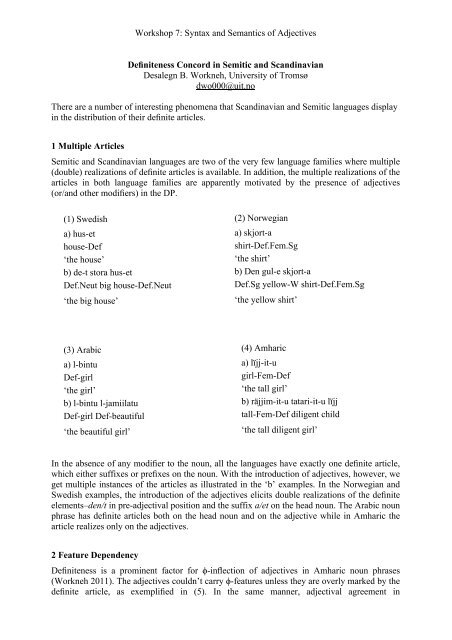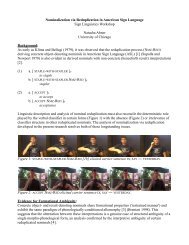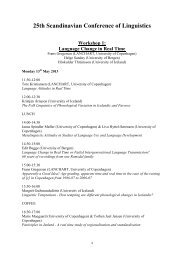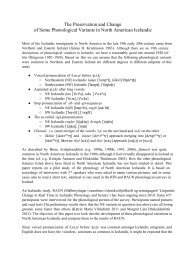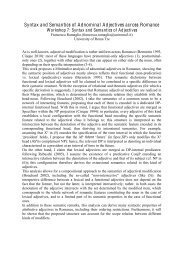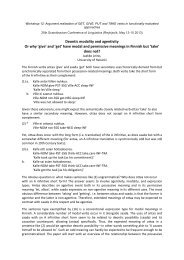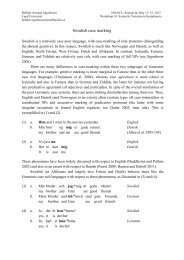Workshop 7: Syntax and Semantics of Adjectives ! ! Definiteness ...
Workshop 7: Syntax and Semantics of Adjectives ! ! Definiteness ...
Workshop 7: Syntax and Semantics of Adjectives ! ! Definiteness ...
Create successful ePaper yourself
Turn your PDF publications into a flip-book with our unique Google optimized e-Paper software.
!<br />
<strong>Workshop</strong> 7: <strong>Syntax</strong> <strong>and</strong> <strong>Semantics</strong> <strong>of</strong> <strong>Adjectives</strong><br />
!<br />
<strong>Definiteness</strong> Concord in Semitic <strong>and</strong> Sc<strong>and</strong>inavian<br />
Desalegn B. Workneh, University <strong>of</strong> Tromsø<br />
dwo000@uit.no<br />
There are a number <strong>of</strong> interesting phenomena that Sc<strong>and</strong>inavian <strong>and</strong> Semitic languages display<br />
in the distribution <strong>of</strong> their definite articles.!<br />
1 Multiple Articles<br />
Semitic <strong>and</strong> Sc<strong>and</strong>inavian languages are two <strong>of</strong> the very few language families where multiple<br />
(double) realizations <strong>of</strong> definite articles is available. In addition, the multiple realizations <strong>of</strong> the<br />
articles in both language families are apparently motivated by the presence <strong>of</strong> adjectives<br />
(or/<strong>and</strong> other modifiers) in the DP.<br />
(1) Swedish<br />
a) hus-et<br />
house-Def<br />
‘the house’<br />
b) de-t stora hus-et<br />
Def.Neut big house-Def.Neut<br />
‘the big house’<br />
!<br />
(2) Norwegian<br />
a) skjort-a<br />
shirt-Def.Fem.Sg<br />
‘the shirt’<br />
b) Den gul-e skjort-a<br />
Def.Sg yellow-W shirt-Def.Fem.Sg<br />
‘the yellow shirt’<br />
!<br />
(3) Arabic<br />
a) l-bintu<br />
Def-girl<br />
‘the girl’<br />
b) l-bintu l-jamiilatu<br />
Def-girl Def-beautiful<br />
‘the beautiful girl’<br />
!<br />
(4) Amharic<br />
a) lïjj-it-u<br />
girl-Fem-Def<br />
‘the tall girl’<br />
b) räjjim-it-u tatari-it-u lïjj<br />
tall-Fem-Def diligent child<br />
‘the tall diligent girl’!<br />
!<br />
In the absence <strong>of</strong> any modifier to the noun, all the languages have exactly one definite article,<br />
which either suffixes or prefixes on the noun. With the introduction <strong>of</strong> adjectives, however, we<br />
get multiple instances <strong>of</strong> the articles as illustrated in the ‘b’ examples. In the Norwegian <strong>and</strong><br />
Swedish examples, the introduction <strong>of</strong> the adjectives elicits double realizations <strong>of</strong> the definite<br />
elements–den/t in pre-adjectival position <strong>and</strong> the suffix a/et on the head noun. The Arabic noun<br />
phrase has definite articles both on the head noun <strong>and</strong> on the adjective while in Amharic the<br />
article realizes only on the adjectives.<br />
2 Feature Dependency<br />
<strong>Definiteness</strong> is a prominent factor for !-inflection <strong>of</strong> adjectives in Amharic noun phrases<br />
(Workneh 2011). The adjectives couldn’t carry !-features unless they are overly marked by the<br />
definite article, as exemplified in (5). In the same manner, adjectival agreement in
<strong>Workshop</strong> 7: <strong>Syntax</strong> <strong>and</strong> <strong>Semantics</strong> <strong>of</strong> <strong>Adjectives</strong><br />
!<br />
Sc<strong>and</strong>inavian languages exhibits distinctions between definite <strong>and</strong> indefinite environments.<br />
<strong>Adjectives</strong> appear in “weak” inflectional form, where gender <strong>and</strong> number features are barely<br />
visibly marked, in definite environments as in (6-a) whereas they explicitly inflect (“strong”)<br />
for these !-features in indefinite environments, as in (6-b).<br />
(5) Amharic<br />
a) räjjïm-it-u lïjj<br />
tall-Fem-Def child<br />
‘the tall girl’<br />
b) <strong>and</strong>-it räjjïm-(*it) lïjj<br />
One-Fem tall-(*Fem) child<br />
‘a tall girl’<br />
(6) Norwegian<br />
a) det fin-e hus-et<br />
Def.N.Sg nice-W house-Def.N.Sg<br />
‘the nice house’<br />
b) eit fin-t hus<br />
InD.N.Sg nice-N.Sg house<br />
‘a nice house’<br />
Specifically focusing on the Amharic <strong>and</strong> Swedish data, in the presentation, I will demonstrate<br />
that definiteness concord in these languages is Reverse Agree (Zeijlstra 2011,2012)<br />
phenomenon. Decomposing what we customarily call D-projection into layers <strong>of</strong> multiple<br />
projections (Béjar & Rezac 2009) I will show that the adjectives play a prominent role in<br />
blocking <strong>and</strong>/or triggering agreement between the head noun <strong>and</strong> the functional projections.<br />
While the structures are similar at the abstract, narrow syntax level (Chomsky 2001), I will<br />
argue, the internal makeup <strong>of</strong> the adjectives a.k.a lexical size in the Nano<strong>Syntax</strong> literature<br />
(Starke 2011), is the ultimate source <strong>of</strong> the <strong>of</strong> the visible variations in the distribution <strong>of</strong><br />
definite articles across these language groups.<br />
References<br />
Béjar, S. & Rezac, M. (2009), Cyclic agree, Linguistic Inquiry 40(1), 35–73.<br />
Chomsky, N. (2001), Derivation by phase,in K. L. Hale & M. J. Kenstowicz, eds, ‘Ken Hale:<br />
A life in language’, Mass.: MIT Press, Cambridge, pp. 1–52<br />
Starke, M. (2011), Towards elegant parameters: Language variation reduces to the size <strong>of</strong><br />
lexically stored trees. URL:http://ling.auf.net/lingBuzz/001183!<br />
Workneh, D. B. (2011), Dp internal agreement in Amharic : a Reverse Agree Solution.<br />
URL:http://www.ub.uit.no/munin/h<strong>and</strong>le/10037/3537!<br />
Zeijlstra, H. (2011), Interpretable <strong>and</strong> uninterpretable features. A talk given at CASTL<br />
Colloquium; University <strong>of</strong> Tromsø.<br />
Zeijlstra, H. (2012), There is only one way to agree. URL:http://ling.auf.net/lingBuzz/001435


